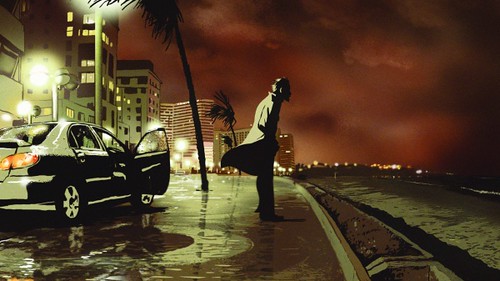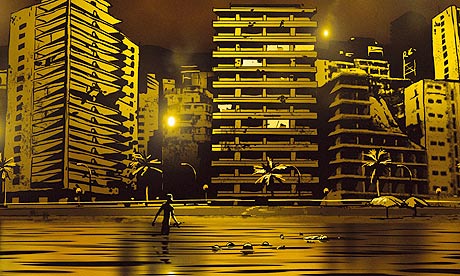 As a preface to this review, I should probably note that I am a non-practicing Jew who has spent a decent amount of time in Israel and has many friends currently in the Israeli army. I say this because these facts made it very difficult to simply review Ari Folman's Waltz with Bashir on an intellectual level. This was one of the most emotional movie-going experiences I've ever had. This animated documentary (I'll get to that later) is one of the most highly acclaimed films in Israeli history, and was one of my most anticipated films of 2008. It has already won the Golden Globe for best foreign language film and is the front-runner for the Oscar in that category as well as a dark horse in the best animated feature category (although I'd be shocked if anything actually beat Wall-E). When I first heard that this was an animated documentary, I really didn't know what to think. It just sounded like too much of a contradiction, unless you count an animated educational film as a documentary. Waltz With Bashir has advertised itself as the first feature-length animated documentary, and, given the way it is filmed, I agree with that label. The film is centered around a series of interviews and discussions between Folman and others who were with him in the 1982 war with Lebanon. These sequences were first filmed in a studio, and then the animators drew them separately (it was not rotoscoped, like Waking Life or A Scanner Darkly, which is where they animate over the actual image). Then their interviews lead to a story of flashbacks and hallucinations about the war. At first I didn't realize how these could be considered part of a documentary, but I realized that they are no different from the reenactments in The Thin Blue Line, except in that they use a separate medium.
As a preface to this review, I should probably note that I am a non-practicing Jew who has spent a decent amount of time in Israel and has many friends currently in the Israeli army. I say this because these facts made it very difficult to simply review Ari Folman's Waltz with Bashir on an intellectual level. This was one of the most emotional movie-going experiences I've ever had. This animated documentary (I'll get to that later) is one of the most highly acclaimed films in Israeli history, and was one of my most anticipated films of 2008. It has already won the Golden Globe for best foreign language film and is the front-runner for the Oscar in that category as well as a dark horse in the best animated feature category (although I'd be shocked if anything actually beat Wall-E). When I first heard that this was an animated documentary, I really didn't know what to think. It just sounded like too much of a contradiction, unless you count an animated educational film as a documentary. Waltz With Bashir has advertised itself as the first feature-length animated documentary, and, given the way it is filmed, I agree with that label. The film is centered around a series of interviews and discussions between Folman and others who were with him in the 1982 war with Lebanon. These sequences were first filmed in a studio, and then the animators drew them separately (it was not rotoscoped, like Waking Life or A Scanner Darkly, which is where they animate over the actual image). Then their interviews lead to a story of flashbacks and hallucinations about the war. At first I didn't realize how these could be considered part of a documentary, but I realized that they are no different from the reenactments in The Thin Blue Line, except in that they use a separate medium. As the film opens, Folman sits in a bar with an old friend from the war who explains a recurring dream in which he is chased down the street by 26 angry dogs. In Lebanon, they knew he couldn't kill humans, so his commanders made him kill the guard dogs instead, and he sees this recurrent nightmare as his punishment. After this interviews, Folman realizes that he doesn't remember a thing about the war except for one hypnotic flashback where he and two others wake up in the ocean and walk into Beirut, only to see a large crowd fleeing the Sabra and Shatila massacres, in which a large group of Christian Lebanese entered two Palestinian refugee camps and slaughtered the refugees while the Israeli guards just stood by, paralyzed by the chain of command. Folman goes to interview one of the men who was in the dream (he can't remember the other), and, through interviews with him and various others who were there in that time, he begins to put together what happened. Through this, we get a series of fascinating, interconnected vignettes about the war and its effect on people. The only one of these that doesn't work perfectly involves Folman working a VCR so his colonel can watch porn; however this is soon followed by the best scene in the film. As they entered Beirut following the assassination of Lebanese leader Bachir Gemayel (pronounced Bashir), Folman's company faced heavy enemy fire. After a few minutes, his commander knew that they needed to cross the street, so he grabbed a heavy machine gun and walked out, shooting into the air, performing a crazed Waltz amid the gunfire and posters of the fallen leader. Near the end of the film, there is an abrupt switch from animation to archival footage. This scene, aside from showing the true effects of war in far greater detail, perfectly uses the dreamlike imagery of animation to contrast the real, and reminds us of the line between dream, memory and fact.
As the film opens, Folman sits in a bar with an old friend from the war who explains a recurring dream in which he is chased down the street by 26 angry dogs. In Lebanon, they knew he couldn't kill humans, so his commanders made him kill the guard dogs instead, and he sees this recurrent nightmare as his punishment. After this interviews, Folman realizes that he doesn't remember a thing about the war except for one hypnotic flashback where he and two others wake up in the ocean and walk into Beirut, only to see a large crowd fleeing the Sabra and Shatila massacres, in which a large group of Christian Lebanese entered two Palestinian refugee camps and slaughtered the refugees while the Israeli guards just stood by, paralyzed by the chain of command. Folman goes to interview one of the men who was in the dream (he can't remember the other), and, through interviews with him and various others who were there in that time, he begins to put together what happened. Through this, we get a series of fascinating, interconnected vignettes about the war and its effect on people. The only one of these that doesn't work perfectly involves Folman working a VCR so his colonel can watch porn; however this is soon followed by the best scene in the film. As they entered Beirut following the assassination of Lebanese leader Bachir Gemayel (pronounced Bashir), Folman's company faced heavy enemy fire. After a few minutes, his commander knew that they needed to cross the street, so he grabbed a heavy machine gun and walked out, shooting into the air, performing a crazed Waltz amid the gunfire and posters of the fallen leader. Near the end of the film, there is an abrupt switch from animation to archival footage. This scene, aside from showing the true effects of war in far greater detail, perfectly uses the dreamlike imagery of animation to contrast the real, and reminds us of the line between dream, memory and fact. I really can not express my admiration for this film enough. Every little detail was alternatively fascinating and heartbreaking. The animation was both dreamlike and beautiful, perfectly capturing the feel and the themes of the film. The score, which won composer Max Richter best composer at the European film awards, is occasionally overbearing, but otherwise perfect, especially during the main hallucinatory sequence. Folman is a perfect guide for this journey, always allowing the story to come out on it's own, and the interviewees, from his friends to the reporters to the military higher-ups at the end, all give us the exact piece of the puzzle that we need from them. My emotional connection to the people and places in the film certainly helped my personal reaction to the story. I can't deny that, but this is an important film, especially now, and it is something that everyone should see. Waltz with Bashir really is one of the best and most innovative films of 2008.
I really can not express my admiration for this film enough. Every little detail was alternatively fascinating and heartbreaking. The animation was both dreamlike and beautiful, perfectly capturing the feel and the themes of the film. The score, which won composer Max Richter best composer at the European film awards, is occasionally overbearing, but otherwise perfect, especially during the main hallucinatory sequence. Folman is a perfect guide for this journey, always allowing the story to come out on it's own, and the interviewees, from his friends to the reporters to the military higher-ups at the end, all give us the exact piece of the puzzle that we need from them. My emotional connection to the people and places in the film certainly helped my personal reaction to the story. I can't deny that, but this is an important film, especially now, and it is something that everyone should see. Waltz with Bashir really is one of the best and most innovative films of 2008.Rating (out of ****): ****
No comments:
Post a Comment